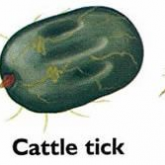Cattle tick
Alert
Have you seen cattle ticks?
Be on the lookout for cattle ticks outside the cattle tick infested zone and report it to Biosecurity Queensland.
Early detection and reporting are the key elements in controlling cattle tick.
Call Biosecurity Queensland on 13 25 23.

Two engorged adult female cattle ticks
© Queensland Government

Boophilus females at various sizes
© Queensland Government

Comparison image of bush tick, cattle tick and paralysis tick
© Queensland Government

Cattle tick life cycle
© Queensland Government
The cattle tick is an external parasite, mainly of cattle, and is regarded as a significant economic pest of the Queensland cattle industry. Cattle ticks are notifiable when they occur outside the Queensland cattle tick infested zone and must be reported to Biosecurity Queensland.
Under Queensland legislation, if you suspect the presence of cattle ticks outside the cattle infested tick zone, you must report it to Biosecurity Queensland on 13 25 23 or contact the Emergency Disease Hotline on 1800 675 888.
Scientific name
Description
Legs are pale cream-coloured with a wide space between the first pair and snout.
- Body – oval to rectangular shape.
- Face – oval, wider at the front.
- Snout – short and straight.
View the tick comparison chart to see the differences between a cattle tick, bush tick and paralysis tick.
Distribution
Queensland's cattle tick infested zone is between the coastal areas east of the Great Dividing Range and north of the Great Northern Rail line. Cattle ticks are also found in the northern areas of Western Australia and Northern Territory and occasionally through the Northern Rivers Region of New South Wales.
Cattle tick outbreaks can and do occur in Queensland's tick free zone. Outbreaks are more common in the marginal areas next to the infested zone.
Life cycle
The cattle tick spends the parasitic stage of its life on the one host. This stage takes approximately 21 days during which time the tick changes from a minute larvae to a nymph and finally an adult.
Adult females feed slowly for about a week before rapidly filling with blood just before detaching. They then drop onto pasture, lay up to 3,000 eggs and die.
Eggs hatch to produce larvae which infest the pasture until picked up by a suitable host, or they die. This non-parasitic stage can vary from approximately 2 months in summer to 6 or 7 months over winter and is adversely affected by extremes in temperature and moisture levels. Males feed occasionally, but do not fill with blood. They wander over the beast for 2 months or more, mating with females.
(See life cycle diagram in image carousel.)
Affected animals
- cattle
- horses
- goats
- sheep
- deer
- camels
- alpaca
- vicuna
- guanacos
- buffaloes
Clinical signs
Ticks can be found anywhere on the body when cattle are heavily infested. Check the escutcheon, tail butt, belly, shoulder, dewlap and ears when there are minimal ticks present.
Impacts
Heavy cattle-tick infestation causes tick-worry and blood loss which leads to loss of condition and sometimes death. They can also carry and transmit tick fever organisms, which cause illness and death in cattle.
If left unchecked, this parasite can significantly reduce cattle live-weight gain and milk production. It can also transmit 3 blood-borne tick fever organisms, which cause sickness and death in cattle.
How it is spread
Cattle ticks are most often spread when they are attached to a host animal.
Risk period
In the north of Queensland, ticks lay viable eggs year round.
In southern Queensland, ticks that fall between mid-April and late June produce virtually no larvae. Engorged female ticks dropped in early autumn can produce eggs and larvae that will survive the winter and eventually result in a spring rise in tick numbers. If not controlled, these ticks breed until there are great numbers in autumn and early winter. Further south, the reproduction cycle slows during winter.
Heavy rain during the wet season can interfere with tick reproduction.
Monitoring and action
Stock owners in the cattle tick free zone should monitor stock regularly to ensure early detection of any cattle tick infestations.
Control
Cattle ticks can be controlled to varying degrees using tick-resistant cattle, treatments with chemicals, pasture spelling or combinations of these methods.
Queensland is divided into 2 tick zones:
- the Queensland infested zone
- the Queensland free zone.
Before entering the tick free zone, stock from the tick infested zone must meet the risk minimisation requirements set out in the Biosecurity manual (PDF, 1.4MB).
Quarantine
When cattle ticks are detected in the free zone, properties are assigned a status of infested or at risk and movement controls are implemented to minimise the spread of cattle ticks. Infested properties in the free zone are obligated to eradicate infestations.